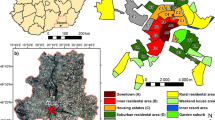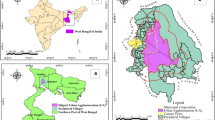Abstract
The fast growth in population and expansion of urban built area has led to the transformation of the natural landscape into impervious surfaces. Remote sensing-based estimate of impervious surface area (ISA) has emerged as an important indicator for the assessment of water resources depletion in urban areas and developed a correlation between land-use change and their potential impact on urban hydrology. In the present work, a remote sensing-based Impervious Surface Area (ISA) was carried out for New Okhla Industrial Development Authority (NOIDA) city, one of the fastest growing cities in National Capital Region (NCR) of India. The impervious surface area (ISA) of NOIDA was calculated for the years 2001, 2007 and 2014 using multi-temporal LANDSAT thermal data by applying linear spectral mixing analysis (LSMA) techniques to monitor the growth rate of impervious surface. The results observed by analysis of multi-temporal satellite images show an extreme temporal change in the growth of ISA in the city. The ISA observed for the year 2001 is 28 sq.km; in 2007, its increase was 48 sq.km and was 132 in 2014. The results were observed from this work through the use of satellite data which is very important for water resource management, planning and prediction of ISA impact on hydrology.







Similar content being viewed by others
References
Adams JB, Sabol DE, Kapos V, Filho RA, Roberts DA, Smith MO et al (1995) Classification of multispectral images based on fractions of endmembers: application to land cover change in the Brazilian Amazon. Remote Sens Environ 52:137–154
Boardman JM, Kruse FA, Green RO (1995) Mapping target signature via partial unmixing of AVIRIS data. Summaries of the Fifth JPL Airborne Earth Science Workshop, vol 95(1). JPL Publication, pp 23–26
Braud I, Breil P, Thollet F, Lagouy M, Branger F, Jacqueminet C, Kermadi S, Michel K (2013) Evidence of the impact of urbanization on the hydrological regime of a medium-sized periurban catchment in France. J Hydrol 485:5–23
Deng Y, Fan F, Chen R (2012) Extraction and analysis of impervious surfaces based on a spectral un-mixing method using Pearl River Delta of China Landsat TM/ETM+ imagery from 1998 to 2008. Sensors 12:1846–1862
Fletcher TD, Andrieu H, Hamel P (2013) Understanding, management and modelling of urban hydrology and its consequences for receiving waters; a state of the art review. Adv Water Resour 51:261–279
Green AA, Berman M, Switzer P, Craig MD (1988) A transformation for ordering multispectral data in terms of image quality with implications for noise removal. IEEE Trans Geosci Remote Sens 26:65–74
Hardison EC, Michael A, John PD, Robert JH, Mark MB (2009) Urban land use, channelincision, and riparian water table decline along inner coastal plain streams, North Carolina. J Am Water Resour Assoc 45(4):1032–1046
Jacobson CR (2011) Identification and quantification of the hydrological impacts of imperviousness in urban catchments: a review. J Environ Manage 92:1438–1448
Kikon N, Singh P, Singh SK, Vyas A (2016) Assessment of urban heat islands (UHI) of Noida City, India using multi-temporal satellite data. Sustain Cities Soc 22:19–28
Lu D, Mausel P, Brondízio E, Moran E (2002) Assessment of atmospheric correction methods for Landsat TM data applicable to Amazon basin LBA research. Int J Remote Sens 23(13):2651–2671
Lu D, Song K, Zeng L, Liu D, Khan S, Zhang B, Wang Z, Jin C (2008a) Estimating impervious surface for the urban area expansion: examples from changchun, northeast china. In: The international archives of the photogrammetry, remote sensing and spatial information sciences, 36( Part B8), pp 385–391
Lu D, Batistella M, Moran E, de Miranda EE (2008b) A comparative study of Landsat TM and SPOT HRG images for vegetation classification in the Brazilian Amazon. Photogram Eng Remote Sens 74(3):311– 321
Markham BL, Barker JL (1986) Landsat MSS and TM post-calibration dynamic ranges, exoatmospheric reflectances and at-satellite temperatures. EOSAT Landsat Technical Notes, No. 1
Mustard JF, Sunshine JM (1999) Spectral analysis for earth science investigations. In: Manual of remote sensing. Remote sensing for the earth sciences, vol 3. Wiley, New York pp 251–307
Rai SC, Saha A (2015) Impact of urban sprawl on groundwater quality: a case study of Faridabad city, National Capital Region of Delhi. Arab J Geosci 8(10):8039–8045
Ridd MK (1995) Exploring a VIS (vegetation-impervious surface soil) model for urban ecosystem analysis through remote sensing: comparative anatomy for cities. Int J Remote Sens 16(12):2165–2185
Roberts DA, Gardner M, Church R, Ustin S, Scheer G, Green RO (1998) Mapping chaparral in the Santa Monica mountains using multiple endmember spectral mixture models. Remote Sens Environ 65:267–279
Shuster WD, Bonta J, Thurston H, Warnemuende E, Smith DR (2005) Impacts of impervioussurface on watershed hydrology: a review. Urban Water J 2(4):263–275. doi:10.1080/15730620500386529
Singh P, Thakur JK, Kumar S, Singh UC (2012) Assessment of land use/land cover using geospatial techniques in a semi-arid region of Madhya Pradesh, India. In: Thakur Singh, Prasad Gossel (eds) Geospatial techniques for managing environmental resources. Springer, Heidelberg, pp 152–163
Small C (2001) Estimation of urban vegetation abundance by spectral mixture analysis. Int J Remote Sens 22(7):1305–1334
Srinivasan V, Karen CS, Emerson R, Steven MG (2013) The impact of urbanization on water vulnerability: a coupled human–environment system approach for Chennai, India. Glob Environ Change 23:229–239
Sugg ZP, Finke P, Goodrich DC, Moran MS, Yool SR (2014) Mapping impervious surfaces using object-oriented classification in a semiarid urban region. Photogramm Eng Remote Sens 80(4):343–352
United Nations (2008) United Nations expert group meeting on population distribution, urbanization, internal migration and development. United Nations Population Division
Van Der Meer F, De Jong SM (2000) Improving the results of spectral un-mixing of Landsat Thematic Mapper imagery by enhancing the orthogonality of end-members. Int J Remote Sens 21:2781–2797
Weng Q (2012) Remote sensing of impervious surfaces in the urban areas: requirements, methods, and trends. Remote Sens Environ 117:34–49
Wu C (2004) Normalized spectral mixture analysis for monitoring urban composition using ETM+ imagery. Remote Sens Environ 93:480–492
Wu C, Murray AT (2003) Estimating impervious surface distribution by spectral mixture analysis. Remote Sensi Environ 84(4):493–505
Xu H (2005) A study on information extraction of water body with the modified normalized difference water index (MNDWI). J Remote Sens 9(5):511–517
Xu H (2007) Etraction of urban built-up land features from Landsat imagery using a thematicoriented index combination technique. Photogram Eng Remote Sens 73(12):1381–1391
Xu H, Wang X, Xiao G (2000) A remote sensing and GIS integrated study on urbanization with its impact on arable lands: Fuqing City, Fujian Province, China. Land Degrad Dev 11(4):301–314
Zhang Y, Ma X, Chen L (2007) Hybrid change detection for watershed impervious surface using multi-time remotely sensed data. In Proceedings of IEEE international geoscience and remote sensing symposium, IGARSS 2007, vol 23(28), Barcelona, Spain, pp 1939–1942
Acknowledgements
The authors express his gratefulness to the Amity University for providing facility and constant encouragement for carried out this research work. Authors are very thankful to the anonymous reviewers for their meaningful comments for improvement of the manuscript.
Author information
Authors and Affiliations
Corresponding author
Rights and permissions
About this article
Cite this article
Sarkar Chaudhuri, A., Singh, P. & Rai, S.C. Assessment of impervious surface growth in urban environment through remote sensing estimates. Environ Earth Sci 76, 541 (2017). https://doi.org/10.1007/s12665-017-6877-1
Received:
Accepted:
Published:
DOI: https://doi.org/10.1007/s12665-017-6877-1




